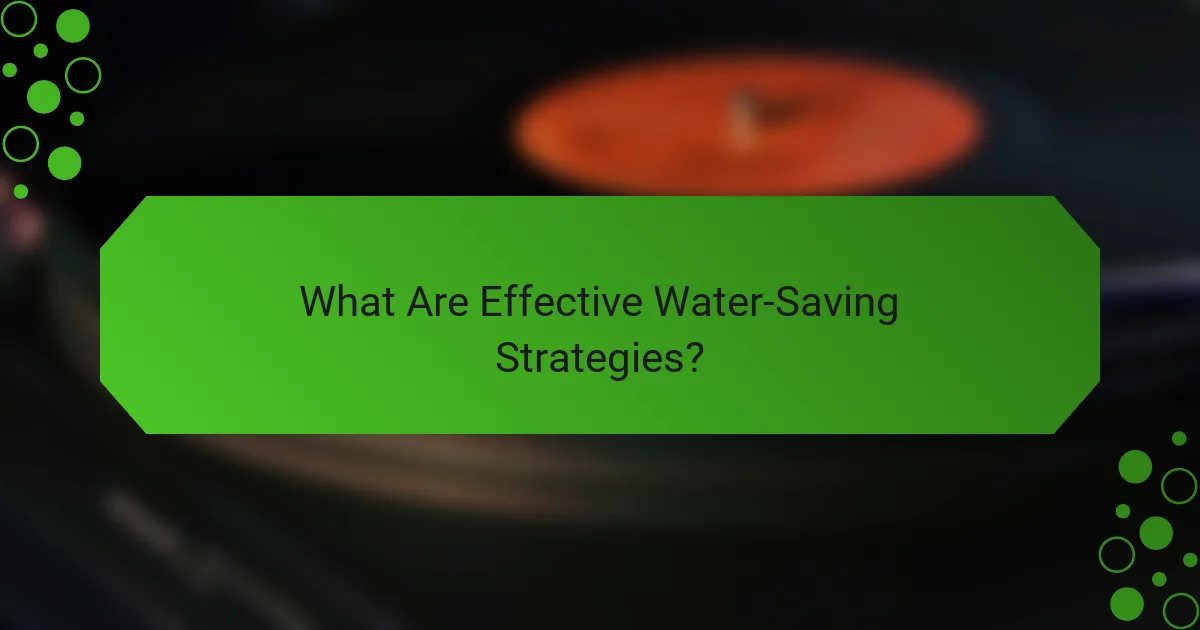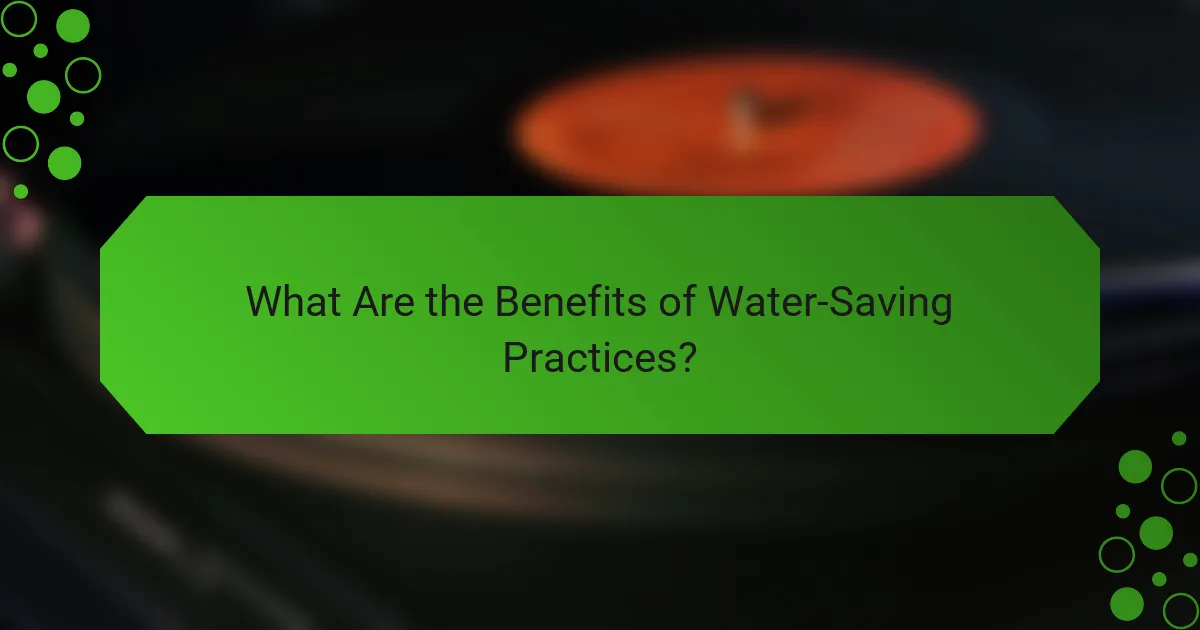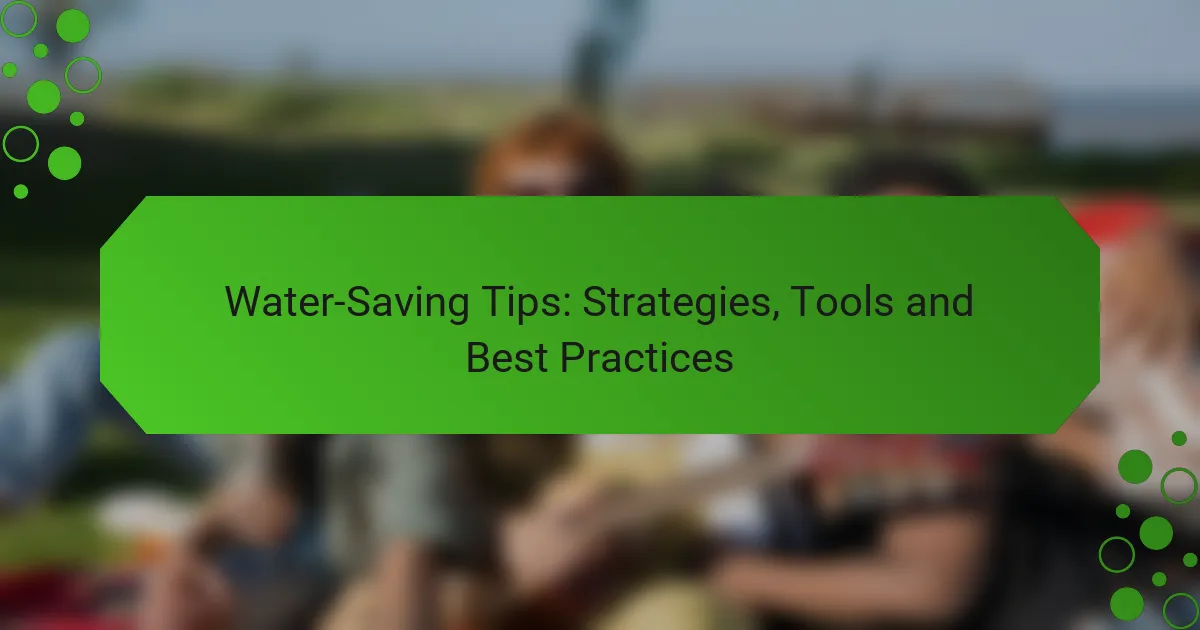Water conservation is crucial for both reducing utility costs and promoting environmental sustainability. By adopting effective strategies and utilizing innovative tools, individuals can significantly decrease their water consumption without sacrificing comfort or functionality. Simple changes in daily habits, along with the installation of efficient fixtures, can lead to substantial savings and a positive impact on our planet.

What Are Effective Water-Saving Strategies?
Effective water-saving strategies focus on reducing consumption while maintaining functionality. Implementing these methods can significantly lower water bills and contribute to environmental sustainability.
Low-flow fixtures
Low-flow fixtures, such as showerheads, faucets, and toilets, are designed to use less water without sacrificing performance. For example, low-flow showerheads can reduce water usage to about 1.5-2.5 gallons per minute, compared to traditional models that may use over 5 gallons.
When selecting low-flow fixtures, look for products that meet EPA WaterSense standards, which ensure efficiency and performance. Installing these fixtures can lead to a noticeable decrease in your water bill while conserving a vital resource.
Rainwater harvesting
Rainwater harvesting involves collecting and storing rainwater for later use, such as irrigation or non-potable applications. This practice can significantly reduce reliance on municipal water sources, especially in regions with seasonal rainfall.
To set up a rainwater harvesting system, install gutters and downspouts that direct rainwater into a storage tank. Ensure the tank is covered to prevent mosquito breeding and contamination. Depending on local regulations, you may need permits or guidelines for installation.
Smart irrigation systems
Smart irrigation systems use technology to optimize watering schedules based on weather conditions and soil moisture levels. These systems can reduce water usage by up to 30-50% compared to traditional irrigation methods.
Consider installing a smart controller that adjusts watering times and amounts automatically. Many systems can connect to weather data or moisture sensors, ensuring your landscape receives the right amount of water without waste.
Native landscaping
Native landscaping involves using plants that are indigenous to your region, which typically require less water and maintenance. These plants are adapted to local climate conditions and can thrive with minimal irrigation once established.
To create a native landscape, research plants that are suited to your area and incorporate them into your garden design. This approach not only conserves water but also supports local wildlife and biodiversity.
Water-efficient appliances
Water-efficient appliances, such as dishwashers and washing machines, are designed to use less water while maintaining cleaning effectiveness. Look for appliances with the ENERGY STAR label, which indicates compliance with water efficiency standards.
When upgrading appliances, consider models that use less than 4 gallons per load for dishwashers and around 15-20 gallons per load for washing machines. Investing in these appliances can lead to substantial water savings over time, reducing both your utility bills and environmental impact.

How Can I Reduce Indoor Water Usage?
Reducing indoor water usage is essential for conserving resources and lowering utility bills. Simple changes in daily habits and the use of efficient fixtures can lead to significant savings.
Shorter showers
Taking shorter showers is one of the easiest ways to cut down on water usage. Aim for showers that last no longer than five minutes, which can save several gallons of water compared to longer showers.
Consider using a timer or a water-saving showerhead that limits flow. These devices can help you stay mindful of your water consumption while still enjoying a refreshing shower.
Fixing leaks
Leaky faucets and toilets can waste a surprising amount of water, often totaling hundreds of gallons per month. Regularly check for leaks and repair them promptly to prevent unnecessary water loss.
Common signs of leaks include dripping sounds, water stains, or an increase in your water bill. Simple fixes like replacing washers or tightening connections can often resolve these issues without professional help.
Using dishwashers efficiently
Using a dishwasher can be more water-efficient than washing dishes by hand, especially if you run it only when fully loaded. Modern dishwashers typically use less water per cycle than manual washing.
To maximize efficiency, avoid pre-rinsing dishes unless necessary, as this can waste additional water. Instead, scrape off food scraps and load the dishwasher according to the manufacturer’s guidelines.
Installing dual-flush toilets
Installing dual-flush toilets can significantly reduce indoor water usage by offering two flushing options: one for liquid waste and another for solid waste. This feature allows users to choose the appropriate flush, conserving water with each use.
Look for toilets that meet WaterSense standards, which indicate they use less water without sacrificing performance. Upgrading to a dual-flush model can lead to substantial savings over time, both in water and costs.

What Tools Help with Water Conservation?
Several tools can significantly aid in water conservation by optimizing usage and reducing waste. These devices help monitor, control, and improve water efficiency in various settings, from homes to gardens.
Water-saving showerheads
Water-saving showerheads are designed to reduce water flow while maintaining pressure, typically using less than 2.5 gallons per minute (GPM). By replacing standard showerheads with low-flow models, households can save substantial amounts of water without sacrificing comfort.
When selecting a water-saving showerhead, look for models that are WaterSense certified, which ensures they meet efficiency standards set by the EPA. Consider features like adjustable spray settings for added versatility.
Irrigation timers
Irrigation timers automate watering schedules, ensuring gardens and lawns receive the right amount of water at optimal times. These devices can help reduce overwatering and conserve water, especially in regions with water restrictions.
Choose a timer that allows for flexible scheduling and can be adjusted based on weather conditions. Some advanced models even connect to weather data to adjust watering based on rainfall, further enhancing water savings.
Soil moisture sensors
Soil moisture sensors measure the moisture level in the ground, providing real-time data to inform watering needs. By using these sensors, gardeners can avoid unnecessary watering, ensuring plants receive adequate hydration without waste.
When implementing soil moisture sensors, place them at root depth for accurate readings. Many sensors can connect to irrigation systems, allowing for automatic adjustments based on soil moisture levels, which can lead to significant water savings over time.

What Are the Benefits of Water-Saving Practices?
Implementing water-saving practices offers significant advantages, including reduced costs, positive environmental effects, and enhanced property value. These benefits can lead to long-term savings and contribute to sustainable living.
Lower utility bills
One of the most immediate benefits of water-saving practices is the reduction in utility bills. By using less water, households can see monthly savings that can range from a few dollars to over a hundred dollars annually, depending on usage and local rates.
Simple measures like fixing leaks, installing low-flow fixtures, and using water-efficient appliances can dramatically lower water consumption. For instance, replacing an old toilet with a modern low-flush model can save several thousand liters of water each year.
Environmental impact
Water-saving practices contribute significantly to environmental conservation. Reducing water usage helps preserve local water sources and ecosystems, which are often stressed by over-extraction and pollution.
Moreover, less water consumption means reduced energy use for water heating and treatment, leading to lower greenhouse gas emissions. Simple actions, such as collecting rainwater for gardening or using drought-resistant plants, can further enhance these environmental benefits.
Increased property value
Homes equipped with water-saving features often have higher property values. Prospective buyers are increasingly looking for properties that demonstrate sustainability and cost-efficiency, making water-efficient homes more attractive in the real estate market.
Investing in water-saving technologies, such as smart irrigation systems or greywater recycling, can yield a return on investment by appealing to eco-conscious buyers. Additionally, properties in regions with strict water regulations may see even greater value appreciation as water scarcity becomes a more pressing issue.

How Do I Choose the Right Water-Saving Products?
Choosing the right water-saving products involves evaluating efficiency, effectiveness, and suitability for your specific needs. Look for products that meet recognized standards and have positive user feedback to ensure they deliver on their promises.
Research product reviews
Product reviews provide insights into the performance and reliability of water-saving tools. Start by checking reputable websites that aggregate user feedback, such as consumer reports or specialized home improvement forums.
Pay attention to both the number of reviews and the overall ratings. A product with a high rating and a substantial number of reviews is often a safer choice than one with few ratings, even if it has a perfect score.
Look for specific comments regarding water savings, ease of installation, and durability. Users often share their experiences with real-world usage, which can highlight potential issues or advantages that specifications alone may not reveal.
